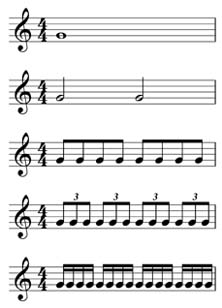A.3. More About Note Values
| < Day Day Up > |
| Music would be pretty boring if it were all written using only quarter-note and eighth -note rhythms . It would be a world of disco. Fortunately, you can chop up a measure of beats into a world of different rhythms. Some notes ring longer than a quarter note; some are played much faster. Figure A-5 shows five different ways to fill four beats, using different kinds of notes. It should help you understand, if only vaguely, the listings in GarageBand's Grid pop-up menus . One category in those pop-up menus, however, might puzzle you at first: this business of swing . As shown on Section B.5.2, you're offered entries like "1/8 Swing Light" and "1/16 Swing Heavy." Swing is a feeling , not a note value. It's a jazz-style way of playing pairs of eighth notes or sixteenth notes so that they, well swing. Technically, the player is supposed to delay the second note of every pair. But emotionally, it's a whole different feeling. Trying to explain it in prose is futile, so listen to the GarageBand file called "07 ”Swing" from the GarageBand Examples CD. (See Section 1.5 for instructions on downloading it.) You'll hear the same snippet of music played with normal eighth notes, and again with both heavy and light swing eighth notes. The truth, though, is that if you're trying to write any kind of jazz, ragtime, or sultry ballad, you'll be awfully glad that GarageBand even understands swing ”a lot of less sophisticated music programs don't. Thanks to the Swing commands in the Grid pop-up menu, you can use the Align To button (Section 5.5.2), for example, to clean up a jazzy performance without losing its swingy feel.
|
| < Day Day Up > |
